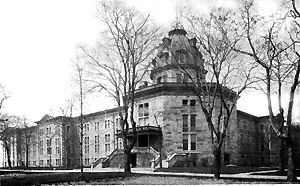|
by Neil Tandon for the Roosevelt Island Historical Society© OCTAGON TOWER
This crumbling gray gneiss ruin belies its rich past. The erstwhile corridors bore the footprints of Charles Dickens and Nellie Bly. Its grand rotunda once held the blue ribbon in interior beauty. The Octagon Tower's beauty was once a mask for an institution of despair, the New York City Asylum for the Insane. The lonely Octagon Tower once had the company of the Asylum's two projecting wings. The Octagon was the Asylum's administrative center and main entrance hall. When the facility opened in 1839, it was a much-needed relief to the overcrowded wards of Bellevue Hospital. The building was designed by noted architect Alexander Jackson Davis, credited in New York with Wall Street's Federal Hall.
The Lunatic Asylum's objective was not confinement but treatment. Therapy often consisted of entertainment, activity, and physical labor. Men worked on the seawall and in the vegetable gardens, while women served as housekeepers and seamstresses.
After his 1842 visit, Charles Dickens wrote in his American Notes about the "lounging, listless, madhouse air" that prevailed. Diseases such as scurvy, typhus, and cholera all took their turns. Overcrowding and financial difficulties were practically givens. Even with added buildings, conditions ten years later were not at all better. In a famous undercover operation for the New York World, journalist Nellie Bly (real name Elizabeth Cochrane) feigned insanity and was sent to the Asylum. In 1887 after a World attorney obtained her release, she gained national recognition, writing a series of front page articles detailing her harrowing experiences.
Metropolitan Hospital joined this island's City Hospital as two of the world's largest medical institutions. Accommodating nearly 1,400 patients, Metropolitan held general medical facilities but specialized in tuberculosis. (From 1902 to 1921, it also housed a leprosy ward.) In 1955 Metropolitan abandoned these buildings for new quarters on First Avenue and 97 Street. Now, only the Octagon Tower stands. In 1975 it was designated a city landmark and was partially restored. As a ruin, however, this structure has suffered the pangs of vandalism. In 1982 vandals torched its roof, and for the next ten years, the interior was battered by the elements. Over Labor Day weekend 1999, a fire obliterated much of the building's upper portion and caused extensive damage to the interior. |



